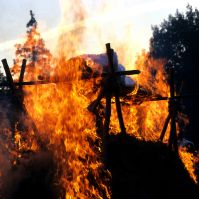 As Americans become ever less religious, so too have our celebrated life milestones such as births, weddings, and funerals. Many of these celebrations are no longer held in a church, synagogue, or mosque, presided over by a priest, rabbi, or imam. Instead, more families are opting for a secular celebration specifically focusing on the individual. When it comes to funerals, these secular celebrations have become known as humanist funerals or humanist memorial celebrations. Why? Because they focus on the deceased as a human being rather than focusing on the traditions established by a particular religion.
As Americans become ever less religious, so too have our celebrated life milestones such as births, weddings, and funerals. Many of these celebrations are no longer held in a church, synagogue, or mosque, presided over by a priest, rabbi, or imam. Instead, more families are opting for a secular celebration specifically focusing on the individual. When it comes to funerals, these secular celebrations have become known as humanist funerals or humanist memorial celebrations. Why? Because they focus on the deceased as a human being rather than focusing on the traditions established by a particular religion.
Humanist Funeral Program
In general, a humanist memorial service follows the following format:
- One, two, or more musical selections, either instrumental or vocal, especially meaningful to the deceased
- Opening remarks by the secular celebrant or the funeral director if the celebration is being held in a funeral home
- Tributes by various members of his or her family or circle of friends
- One, two, or more readings of poetry or prose
- A time of silent reflection by the people attending the celebration
- Closing words by the secular celebrant or the funeral director
- A closing song
- Processional to the cemetery if the deceased’s body or ashes are going to be interred
Additional Options
Once you remove religious aspects from a funeral, your options for where and how to conduct the celebration are virtually never-ending. For instance, who says the celebration must be held in a house of worship or a funeral home? Why not a park? Why not a river bank? Why not the deceased’s back yard or the back yard of a special family member or friend? Any location is acceptable as long as it had meaning to your loved one.
Remember, a funeral or memorial service should create memories about the deceased for those who loved him or her. Consequently, consider having numerous photos of the deceased sharing fun times with his or her family or friends sitting or hanging in the venue. If you have videos, so much the better. Play them in a loop somewhere so that everyone will have ample opportunity to view them.
And don’t be afraid to “shake things up,” especially after the ceremony itself ends. Rather than adjourning to the deceased’s home or a restaurant where everyone will sit around with long faces, consider holding the post-funeral reception in your loved one’s favorite bar. You may find that the toasts offered by his or her best buddies at a favorite watering hole far outweigh the remarks made at the actual service, and holding the reception in a less-somber place may help mourners share stories.
If your loved one was cremated, nowhere is it written that the remains must be buried in the grounds of a cemetery. They can be sprinkled in the ocean from the deck of a boat or ship or even on the shoreline. They likely can be sprinkled at the Grand Canyon or other place of special beauty if you get the necessary permissions. Some sprinkling ceremonies have even been known to travel into the air as part of a skydiving celebration!
Given that funerals are and always have been more about the grieving family and friends than about the dead person, a humanist funeral or memorial service has the potential to give you and other friends and family considerably more comfort than a traditional religious funeral. How? Unlike a traditional funeral that proceeds according to a ritualized formula with which many people in attendance may be unfamiliar, a humanist funeral focuses on the person who has died and what he or she meant to family and friends. In other words, a humanist funeral is exactly that — human.



